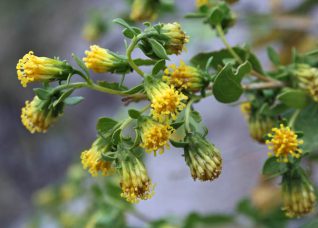
MinerAlert

MinerAlert
Flourensia cernua - Asteraceae
Blackbrush, Varnish bush, American Tarwort, Hojasén, Hojasé, Ojasé
This plant should not be confused with another herb with a very similar common name in Spanish, also used in Mexican traditional medicine, and known as “Hoja de Sen” (Cassia senna -Fabaceae), which is an entirely different species (McGuffin, et al., 2000).

This shrubby plant grows wild in various semi-arid regions of the Southwestern United Sates and Northern Mexico.
The leaves and stems.
In parts of northern Mexico, the leaves and stems are boiled with water (decoction) and taken as a medicinal tea.
The tea is taken primarily to relieve various gastrointestinal problems, including indigestion, flatulence, and parasites. It is also taken as a purgative (Martínez, 1989).
Tarbush has been found to contain diverse antioxidant and potentially anti-inflammatory compounds (phytochemicals) that inactivate noxious free radicals and therefore may be useful in the treatment of various diseases (Wong-Paz et al., 2015).
Recent data show that tarbush tea is also taken in traditional Mexican medicine as an expectorant for the treatment of respiratory infections, including serious bacterial diseases such as tuberculosis.
The findings from a research study undertaken by Molina-Salinas et al.(2011) supported the popular use of this plant for the treatment of respiratory infections and also suggested that tarbush should be further investigated as a possible treatment for people infected with bacterial multidrug-resistant M ycobacterium tuberculosis strains.
Among various medicinal plants evaluated by Molina-Salinas, et al. (2006) for antibacterial activity, tarbush proved to be especially active against Mycobacterium tuberculosis, the causative agent of this reemerging and sometimes deadly disease. Therefore, the researchers concluded that extracts made from tarbush leaves could be an important source of bactericidal compounds against multidrug-resistant M. tuberculosis.
Before you decide to take any medicinal herb or herbal supplement, be sure to consult with your health care professional first. Avoid self-diagnosis and self-medication: Always be on the safe side!